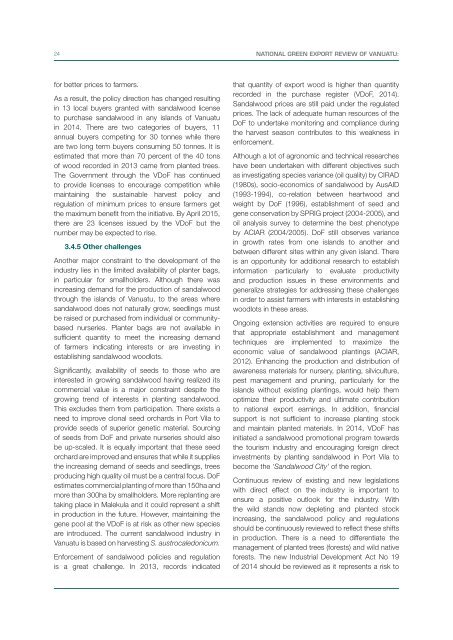VANUATU
Qffx302d60u
Qffx302d60u
Create successful ePaper yourself
Turn your PDF publications into a flip-book with our unique Google optimized e-Paper software.
24 National Green Export Review of Vanuatu:<br />
for better prices to farmers.<br />
As a result, the policy direction has changed resulting<br />
in 13 local buyers granted with sandalwood license<br />
to purchase sandalwood in any islands of Vanuatu<br />
in 2014. There are two categories of buyers, 11<br />
annual buyers competing for 30 tonnes while there<br />
are two long term buyers consuming 50 tonnes. It is<br />
estimated that more than 70 percent of the 40 tons<br />
of wood recorded in 2013 came from planted trees.<br />
The Government through the VDoF has continued<br />
to provide licenses to encourage competition while<br />
maintaining the sustainable harvest policy and<br />
regulation of minimum prices to ensure farmers get<br />
the maximum benefit from the initiative. By April 2015,<br />
there are 23 licenses issued by the VDoF but the<br />
number may be expected to rise.<br />
3.4.5 Other challenges<br />
Another major constraint to the development of the<br />
industry lies in the limited availability of planter bags,<br />
in particular for smallholders. Although there was<br />
increasing demand for the production of sandalwood<br />
through the islands of Vanuatu, to the areas where<br />
sandalwood does not naturally grow, seedlings must<br />
be raised or purchased from individual or communitybased<br />
nurseries. Planter bags are not available in<br />
sufficient quantity to meet the increasing demand<br />
of farmers indicating interests or are investing in<br />
establishing sandalwood woodlots.<br />
Significantly, availability of seeds to those who are<br />
interested in growing sandalwood having realized its<br />
commercial value is a major constraint despite the<br />
growing trend of interests in planting sandalwood.<br />
This excludes them from participation. There exists a<br />
need to improve clonal seed orchards in Port Vila to<br />
provide seeds of superior genetic material. Sourcing<br />
of seeds from DoF and private nurseries should also<br />
be up-scaled. It is equally important that these seed<br />
orchard are improved and ensures that while it supplies<br />
the increasing demand of seeds and seedlings, trees<br />
producing high quality oil must be a central focus. DoF<br />
estimates commercial planting of more than 150ha and<br />
more than 300ha by smallholders. More replanting are<br />
taking place in Malekula and it could represent a shift<br />
in production in the future. However, maintaining the<br />
gene pool at the VDoF is at risk as other new species<br />
are introduced. The current sandalwood industry in<br />
Vanuatu is based on harvesting S. austrocaledonicum.<br />
Enforcement of sandalwood policies and regulation<br />
is a great challenge. In 2013, records indicated<br />
that quantity of export wood is higher than quantity<br />
recorded in the purchase register (VDoF, 2014).<br />
Sandalwood prices are still paid under the regulated<br />
prices. The lack of adequate human resources of the<br />
DoF to undertake monitoring and compliance during<br />
the harvest season contributes to this weakness in<br />
enforcement.<br />
Although a lot of agronomic and technical researches<br />
have been undertaken with different objectives such<br />
as investigating species variance (oil quality) by CIRAD<br />
(1980s), socio-economics of sandalwood by AusAID<br />
(1993-1994), co-relation between heartwood and<br />
weight by DoF (1996), establishment of seed and<br />
gene conservation by SPRIG project (2004-2005), and<br />
oil analysis survey to determine the best phenotype<br />
by ACIAR (2004/2005). DoF still observes variance<br />
in growth rates from one islands to another and<br />
between different sites within any given island. There<br />
is an opportunity for additional research to establish<br />
information particularly to evaluate productivity<br />
and production issues in these environments and<br />
generalize strategies for addressing these challenges<br />
in order to assist farmers with interests in establishing<br />
woodlots in these areas.<br />
Ongoing extension activities are required to ensure<br />
that appropriate establishment and management<br />
techniques are implemented to maximize the<br />
economic value of sandalwood plantings (ACIAR,<br />
2012). Enhancing the production and distribution of<br />
awareness materials for nursery, planting, silviculture,<br />
pest management and pruning, particularly for the<br />
islands without existing plantings, would help them<br />
optimize their productivity and ultimate contribution<br />
to national export earnings. In addition, financial<br />
support is not sufficient to increase planting stock<br />
and maintain planted materials. In 2014, VDoF has<br />
initiated a sandalwood promotional program towards<br />
the tourism industry and encouraging foreign direct<br />
investments by planting sandalwood in Port Vila to<br />
become the ‘Sandalwood City’ of the region.<br />
Continuous review of existing and new legislations<br />
with direct effect on the industry is important to<br />
ensure a positive outlook for the industry. With<br />
the wild stands now depleting and planted stock<br />
increasing, the sandalwood policy and regulations<br />
should be continuously reviewed to reflect these shifts<br />
in production. There is a need to differentiate the<br />
management of planted trees (forests) and wild native<br />
forests. The new Industrial Development Act No 19<br />
of 2014 should be reviewed as it represents a risk to


